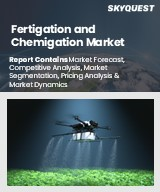
세계의 시비 관개 및 약제 관개 시장 규모는 2023년에 455억 달러로 평가되며, 2024년 487억 8,000만 달러에서 2032년에는 850억 7,000만 달러로 성장하며, 예측 기간(2025-2032년)의 CAGR은 7.2%로 성장할 전망입니다.
세계 비료 관개 및 약제 관개 시장은 물 부족에 대한 우려 증가, 비료 비용 상승으로 인한 효율성 개선의 필요성, 영양 공급 시스템에서 IoT 및 AI 기술의 발전으로 인해 큰 폭의 성장을 보이고 있습니다. 이러한 발전은 작업 낭비를 최소화하고 기후 변화에 대한 내성을 강화함으로써 농장 관리 관행을 재구성하고 있습니다. 기업은 수용성 제제, 클라우드 기반 제어 시스템, 수분, 염분 및 영양소 수준을 모니터링하는 실시간 센서 기술에 초점을 맞춘 연구개발에 많은 투자를 하고 있습니다. 또한 각 지역 정부는 국내 기술 혁신을 지원하면서 마이크로 관개 보조금을 확대하고 장비 업그레이드를 촉진하고 있습니다. 투입재 제조업체는 또한 소프트웨어 솔루션과 농학 서비스를 통합하여 고객 유지 및 부가가치 향상을 위해 노력하고 있습니다.
Global Fertigation and Chemigation Market size was valued at USD 45.5 billion in 2023 and is poised to grow from USD 48.78 billion in 2024 to USD 85.07 billion by 2032, growing at a CAGR of 7.2% during the forecast period (2025-2032).
The global fertigation and chemigation market is experiencing significant growth driven by increasing concerns over water scarcity, rising fertilizer costs that highlight the need for improved efficiency, and the advancement of IoT and AI technologies in nutrient delivery systems. These developments are reshaping farm management practices by minimizing operational waste and enhancing resilience to climate change. Companies are heavily investing in research and development focused on water-soluble formulations, cloud-based control systems, and real-time sensor technologies that monitor moisture, salinity, and nutrient levels. Furthermore, governments in various regions are expanding micro-irrigation subsidies and promoting equipment upgrades while supporting domestic innovation. Input manufacturers are also integrating software solutions and agronomic services to bolster customer retention and add value.
Top-down and bottom-up approaches were used to estimate and validate the size of the Global Fertigation and Chemigation market and to estimate the size of various other dependent submarkets. The research methodology used to estimate the market size includes the following details: The key players in the market were identified through secondary research, and their market shares in the respective regions were determined through primary and secondary research. This entire procedure includes the study of the annual and financial reports of the top market players and extensive interviews for key insights from industry leaders such as CEOs, VPs, directors, and marketing executives. All percentage shares split, and breakdowns were determined using secondary sources and verified through Primary sources. All possible parameters that affect the markets covered in this research study have been accounted for, viewed in extensive detail, verified through primary research, and analyzed to get the final quantitative and qualitative data.
Global Fertigation and Chemigation Market Segments Analysis
Global Fertigation and Chemigation Market is segmented by Agri Input, Crop Type, Application, Irrigation System and region. Based on Agri Input, the market is segmented into Fertilizer, Insecticide, Fungicide, Herbicide and Others. Based on Crop Type, the market is segmented into Field Crops, Plantation Crops, Orchard Crops and Forage & Turf Grasses. Based on Application, the market is segmented into Agriculture Irrigation, Landscape Irrigation, Greenhouse Irrigation and Others. Based on Irrigation System, the market is segmented into Sprinkler Irrigation and Drip Irrigation. Based on region, the market is segmented into North America, Europe, Asia Pacific, Latin America and Middle East & Africa.
Driver of the Global Fertigation and Chemigation Market
The rising global demand for calories is outpacing the availability of arable land, prompting the need for farmers to enhance productivity through efficient use of resources such as water, nutrients, and labor. Fertigation provides a solution by delivering essential nutrients directly to the root zones of plants, resulting in significant increases in crop yields, particularly in high-value crops. By aligning nutrient delivery with the plants' developmental phases, farmers can achieve notable improvements in fertilizer efficiency, thereby lowering costs, especially during fluctuating input prices, while also minimizing nutrient runoff. When combined with climate-smart agricultural practices, fertigation allows for ongoing, data-informed nutrition management rather than relying on conventional, bulk fertilizer applications.
Restraints in the Global Fertigation and Chemigation Market
The Global Fertigation and Chemigation market faces several constraints due to the high initial costs associated with advanced drip fertigation systems. These systems necessitate substantial infrastructure investments, such as pressure-regulated mainlines, dual filtration, backflow prevention, and programmable controllers. As a result, many smallholder farmers find these financial requirements prohibitive. Furthermore, economic evaluations show that variable-rate fertigation systems can take decades to provide a return on investment for commodity crops, whereas fixed-rate pivot systems may offer a more manageable payback period. This financial burden is particularly pronounced in low-income areas with small farming operations and limited access to credit resources.
Market Trends of the Global Fertigation and Chemigation Market
The Global Fertigation and Chemigation market is experiencing a significant trend towards the rapid adoption of water-soluble specialty fertilizers, including water-soluble NPK, Ca-Mg blends, and trace mixes. These fertilizers enhance operational efficiency by preventing emitter clogging and enabling multi-nutrient applications in one go. Research indicates that water-soluble fertilizers yield up to 30% higher nutrient-use efficiency than traditional granular options, aligning with the "5 Rs" framework of nutrient management. Manufacturers are innovating products targeted at pH-sensitive crops and high-frequency applications, significantly boosting adoption rates in premium fruit and greenhouse sectors, particularly across Europe and North America, thereby positioning the market for robust growth.